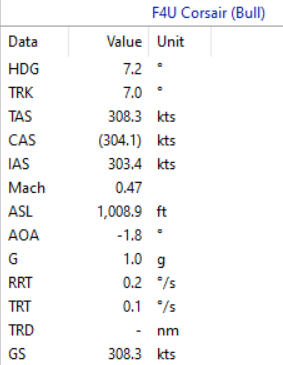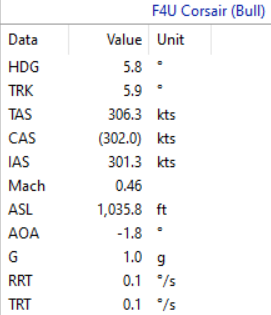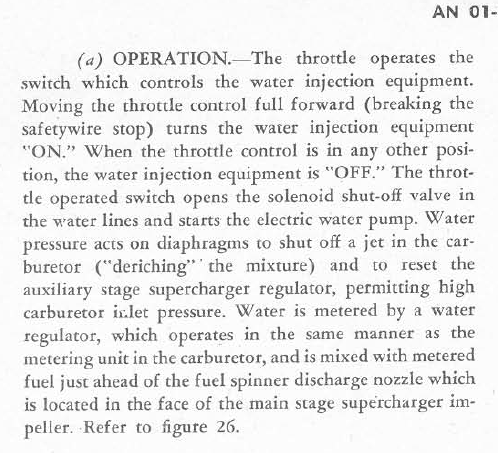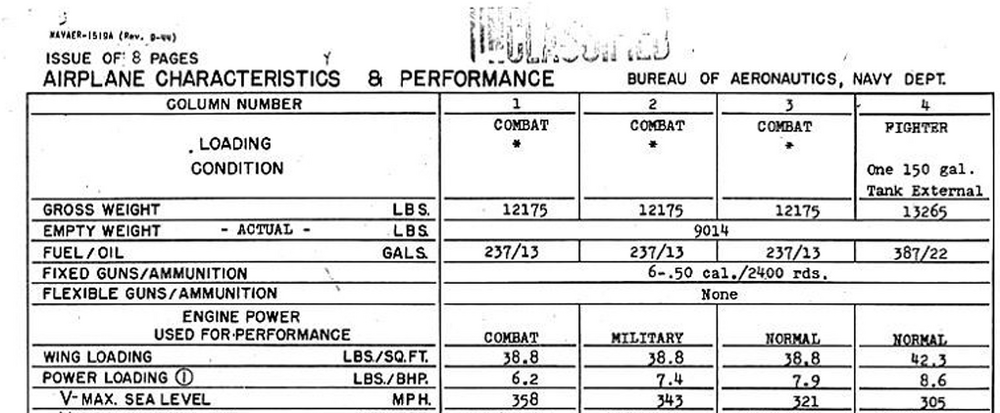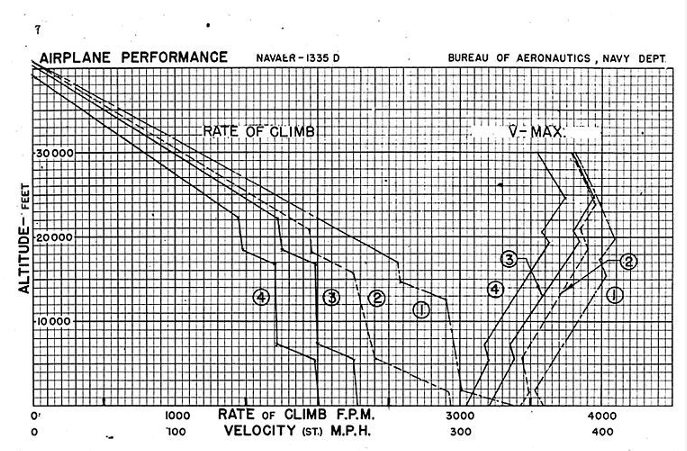-
Posts
637 -
Joined
-
Last visited
Content Type
Profiles
Forums
Events
Everything posted by Invisibull
-
I’ve raised this issue a few times since July 1 regarding the Corsair’s whistling sound effect, but I still haven’t seen any clarification or adjustment. Based on everything I’ve researched, the whistle should only be audible during high‑speed dives or aggressive maneuvers when the oil and/or intercooler flaps are at least partially open. Right now in DCS, I’m still hearing the effect with flaps closed and at relatively modest speeds (around 190 knots). This is simply not how it should be and the fact that the sound file is encrypted means nothing can be done about it except by M3. So my question is simple: Has M3 intentionally decided to model an incorrect implementation here, or is this still under review? At the end of the day, we’re here to fly simulations that respect the aircraft’s historical characteristics. This particular implementation really undercuts that premise. thx for your attention. Some sources: Robert "Bob" Brunson (VMF-312): Brunson said: "I never really noticed the whistle from inside the cockpit. But our ground crews would mention how it shrieked coming in low over the strip." He added that the sound was more psychological warfare than something pilots relied on. Lt. Col. Ken Walsh (VMF-124), Medal of Honor recipient: Walsh confirmed that the Corsair made a noticeable whistle during dives, but emphasized that the pilot could not really hear it over the engine, particularly during combat or when wearing a flight helmet. He noted that ground crews and enemy troops were more aware of it than the pilots themselves. Found in: U.S. Marine Aviation in World War II: VMF 124 in the Solomons And my initial post on the topic with additional evidence:
-
- 2
-

-
What's your opinion of how the whistle sound effect is implemented? Can you hear a whistle sound with closed oil/intercooler flaps at 200 kts in the real thing? If not, at what flap condition/speed can you hear the whistling sound? I've yet to find a source that doesn't 100% disagree with how M3 has chosen to implement the effect so far. thx.
-
Thx GT. You'll also note above that there was an only 2 knots diff between auto lean and auto rich with all else being equal in my speed runs. I think the overarching point is that M3 is in the ballpark, same as what you found with your great F4U Corsair Real-Time Engine Diagnostics Data script, which folks can find here: https://www.digitalcombatsimulator.com/en/files/3346516/ One easy way to know is that when you start hearing the roller coaster clickety clack sound due to high MAP induced engine knock, engaging the water injection will stop the knocking within a few seconds.
-
Did it again with Auto Lean and MAP showed at 57" in the F2 view. You'll notice my velocity increased by 2 kts - almost got to M3's 306. null
-
I did some more testing and it's actually very close now (4 kts slower than expected) - at 1000 feet @ 11,142 lbs, no wind, auto rich and WEP engaged. I used the performance data for weight as the M3 chart does not include that parameter. Once the whistle effect is implemented with historical accuracy, we'll be just about there. nullimage.png
-
They reduced the F4U’s speed by about 7 knots in the latest update. Hopefully, this is just one step in a longer process to fine-tune its performance. I'm also hoping we see a credible Zero AI soon—especially since the real Zero was significantly slower than even the slightly slowed Corsair we have now.
-

Antenna Mast Fluttering, Whistle Effect and Wing Vibration
Invisibull replied to Invisibull's topic in Bugs and Problems
My apologies. I'm sure you're not common. -

Antenna Mast Fluttering, Whistle Effect and Wing Vibration
Invisibull replied to Invisibull's topic in Bugs and Problems
I'm just curious @-Rudel-, has the decision been made to keep the whistling effect as is or have the devs just not gotten around to fixing or at least looking into it yet? Thx. -
The link you provided is a legitimate webpage hosted by ibiblio.org, a well-known digital library and archive run by the University of North Carolina at Chapel Hill. The site is a reputable source for historical documents, particularly those related to military history. Great find! Edit: This link confirms authenticity - https://catalog.archives.gov/id/78294169
-
Looks great! Thx for your efforts.
-
The current implementation of the "enable water injection" key command does not affect MAP. At 1,000 feet and full throttle, MAP remains at 57", regardless of whether the key command is activated.
-
Thanks, never used that one before.
-
Go into F2 view and you'll see exact RPM and speed. I have it mapped for when I do tests like this that need exact values.
-
The key command is currently acting as the throttle detent's micro-switch. The broken wire graphic suggests this is a temporary implementation. I don't think "some guys" are getting extra knots - either everyone is, or no one is. Would be nice if M3 weighed in and explained what we're all seeing.
-
Yes, I do see an increase in speed. The issue is that the increase in power should be primarily the result of the expected increase in manifold pressure, which doesn't happen. It stays the same whether I "enable" the ADI system or not. Aside from the MP, all the other values are pretty much dead on. null
-
Are you referring to "Enable Water Injection"? If so, I have verified the mapping and when I press it, the manifold pressure doesn't change. That's not to say it's not working, just that that keystroke does nothing. From the real flight handbook:
-
Yes, it might be implemented, but without the wire or need to activate the water injection - it's still def a WIP The button press changes nothing, so it seems to not be implemented yet. As said in another post, the lack of a wire to inhibit travel of the throttle makes it pretty obvious that it's still a WIP.
-
I get 57" and about 302 kts at sea level at the weight of 12088 lbs. As far as I can tell, there's no water injection implemented yet.
-
Here's what you should be seeing at sea level with the parameters listed in the doc below - 358 mph / 1.150779 mph/kn ≈ 311.10 knots. Best I could get was about 302 knts. The disparity is even more pronounced at 19,900 as I stated above. Edit: Just noticed that the empty weight for our Corsair is listed as 9903. Maybe that's where the missing 9 knts are going?
-

Antenna Mast Fluttering, Whistle Effect and Wing Vibration
Invisibull replied to Invisibull's topic in Bugs and Problems
You're welcome. Hope it's worth the effort for you. lol -

Antenna Mast Fluttering, Whistle Effect and Wing Vibration
Invisibull replied to Invisibull's topic in Bugs and Problems
OK, I put it in a notepad file, then back into the forum - it should be as plain text as plain text gets. Again, sorry for the hassle. Check again please. -
All we can do is provide the primary sources and hope for the best. Hope springs eternal!
-
Here's some test results from Aug 1945 with an F4U-1D, which you'll notice, is 10 mph faster, even though it's with a combat loadout, so roughly 1000 lbs heavier than the Birdcage when it was tested. http://www.wwiiaircraftperformance.org/f4u/f4u-1d-acp.pdf
-
Yes, that's right - it's right around 330 mph and I agree that you can't seem to get there unless there's at least a slight dive first. The bigger issue, according to the speed trial documentation, is up at 22.8 K' - I should be seeing 250 kts ias (395 mph tas), but I haven't been able to get over 220 kts. That's a 12% shortfall of performance. This is at 11,197 lbs, trimmed out as close to perfect as I can get it, no wind, in high blower, 2700 RPM, 54" manifold and 20C. It's early yet and I have no doubt this will be remedied in short order.


